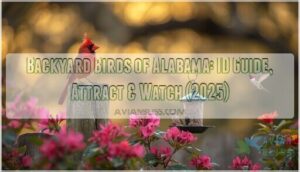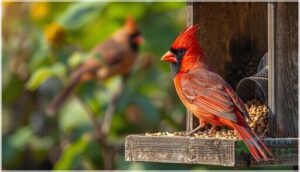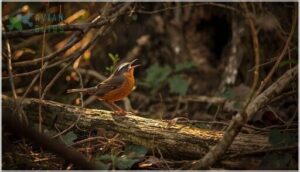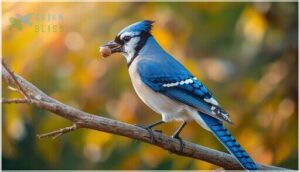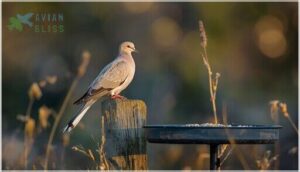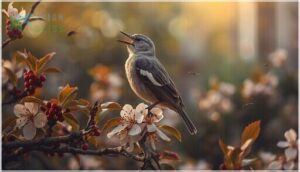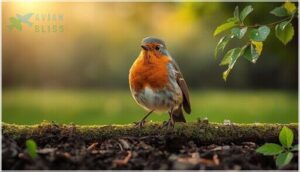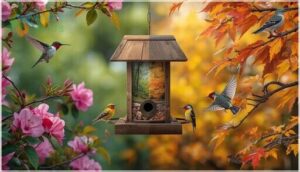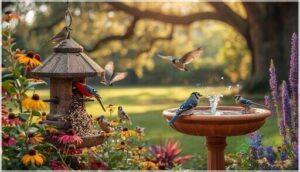This site is supported by our readers. We may earn a commission, at no cost to you, if you purchase through links.
Every morning, a flash of crimson catches your eye as a Northern Cardinal lands on your fence, while a Carolina Wren belts out its tea-kettle melody from somewhere in the azaleas. Alabama’s backyard birds don’t just visit—they put on a show year-round, with some species like Mourning Doves numbering over 83 million across the Eastern United States alone.
Your backyard sits along critical migration routes where Ruby-throated Hummingbirds refuel in spring and Yellow-rumped Warblers appear at feeders come winter. Learning to identify these feathered neighbors by their size, bills, songs, and seasonal patterns transforms your morning coffee into a front-row seat to one of nature’s most accessible spectacles.
With the right feeders, native plants, and a bit of know-how, you can turn your Alabama yard into a haven that attracts cardinals, wrens, jays, and dozens of seasonal visitors throughout the year.
Table Of Contents
- Key Takeaways
- Common Year-Round Backyard Birds in Alabama
- Seasonal Visitors and Migratory Birds in Alabama
- How to Identify Alabama Backyard Birds
- Attracting Birds to Your Alabama Backyard
- Bird Conservation and Watching in Alabama
- Frequently Asked Questions (FAQs)
- How do I identify a bird in my backyard?
- What are the small gray and white birds in Alabama?
- What birds are migrating through Alabama right now?
- What bird is native to Alabama?
- What are the most common backyard birds in Alabama?
- What are the best bird spotting sights in Alabama?
- Are there mockingbirds in Alabama?
- Does Alabama have a Bird Trail?
- Is Turkey a game bird in Alabama?
- How to handle sick or injured birds?
- Conclusion
Key Takeaways
- Alabama’s backyard hosts eight year-round residents like Northern Cardinals and Carolina Wrens, plus seasonal visitors including Ruby-throated Hummingbirds in summer and Yellow-rumped Warblers in winter, with migration routes bringing over 9 million birds through the state during peak seasons.
- Identifying birds becomes straightforward when you focus on size, bill shape, plumage patterns, and songs rather than color alone, since features like sexual dimorphism and seasonal molting can dramatically change a bird’s appearance throughout the year.
- Creating a bird-friendly yard requires black oil sunflower seeds at feeders, shallow water sources cleaned weekly, native plants like American Holly for shelter, and properly mounted nest boxes with predator guards to support breeding populations.
- Alabama’s birding community contributes $1.3 billion annually to the state’s economy while supporting conservation through citizen science platforms like eBird, with 280 designated sites across eight regional trails offering accessible birdwatching opportunities.
Common Year-Round Backyard Birds in Alabama
If you spend any time outdoors in Alabama, you’ll notice certain birds show up no matter the season. These year-round residents have adapted to the state’s climate and food sources, making your backyard their permanent home.
Let’s look at eight common species you’re likely to see throughout the year.
Northern Cardinal
You’ll spot the Northern Cardinal year-round in Alabama—it’s among the state’s most abundant backyard birds, with over 8,700 reports in February alone. Look for these vibrant red residents at your bird feeders, where they prefer sunflower and safflower seeds. They’re classified as being of lowest conservation concern due to their stable population.
They nest in dense shrubs between March and September, raising multiple broods each season while facing threats from cats and window collisions.
Carolina Wren
Unlike the cardinal’s bold appearance, the Carolina Wren announces its presence through its energetic song—one male can use over 30 distinct types for territorial behavior.
You’ll find these small, year-round Alabama residents foraging near ground level, probing under brush and logs where their diet consists of 94% insects.
They’ll raise 2–3 broods annually in your backyard’s dense shrubs, adapting remarkably to human environments. These birds often build nests, a bulky mass of twigs, in various cavities.
Blue Jay
Your backyard’s vivid blue resident with black necklace markings does more than brighten the landscape—Blue Jays cache up to 75% of their diet in acorns, transporting them 2.5 miles and promoting forest growth.
They’re nesting in your trees 8–30 feet up from mid-March through July.
You’ll recognize their extensive Jay vocalizations:
- Harsh jeer calls warn of threats
- Pumphandle whistles signal low-level dangers
- Mimicry skills replicate hawk calls for competitive advantage
- Intrapair contact calls coordinate with mates
Tufted Titmouse
The crested gray silhouette perched on your feeder—that’s the Tufted Titmouse, one of Alabama’s backyard bird identification success stories. With 12 million birds statewide, you’ll spot this year-round resident storing sunflower seeds in your trees, then retrieving them later.
| Feature | Details | What You’ll See |
|---|---|---|
| Nesting Behavior | 5–6 eggs, April–July | Tree cavities 4–55 feet up |
| Feeding Habits | Insects (67%), seeds | Hangs upside down foraging |
| Habitat Expansion | Suburban growth | Stable population trends |
| Conservation Status | Least Concern | Numbers increasing |
Mourning Dove
With over 83 million mourning doves in the Eastern U.S., you’re hearing that gentle cooing daily—Alabama’s most abundant year-round game bird. Their soft gray-brown feathers and slender build make bird identification straightforward. These backyard birds raise three to four broods annually, with nesting habits peaking February through October.
- Seed diet: Hemp, wheat, corn, pigweed, and ragweed
- Nesting habits: Two eggs per clutch, 14-day incubation
- Pigeon milk: Nutrient-rich crop secretion feeds nestlings
- Mortality rate: 70% annually, mostly from natural causes
- Dove hunting: Alabama harvests exceed 1 million yearly
Northern Mockingbird
With its legendary mimicry behavior, the Northern Mockingbird entertains Alabama backyards year-round, copying songs from shrikes to orioles. You’ll spot this 8.3 to 10.2-inch bird by its gray-brown plumage and white wing bars.
Territory defense turns fierce during breeding habits from mid-February to September, when males sing continuously while raising two to three broods.
Their diet variation shifts seasonally—insects in summer, berries in winter.
American Robin
You’ll recognize the American Robin by its brick-red chest and sturdy gray back, measuring 8 to 11 inches.
This year-round resident thrives in Alabama’s lawns and woodlands, where feeding habits shift from earthworms in summer to berries in winter.
Nesting behavior peaks April through July with 2-3 broods per season.
Watch for seasonal migration patterns as large winter flocks form before spring breeding territories.
House Finch
You’ll spot House Finches year-round at your Alabama bird feeders, ranking third among most-sighted backyard birds. Males display rosy-red faces and breasts while females wear streaky brown plumage. Watch for these identifying features:
- Five to 5.5-inch body with shallow-notched tail
- Flat head with long beak
- Plumage brightness varies by diet quality
- Nesting habits include 4-6 pale blue eggs
- Diet variety spans seeds, berries, and occasional aphids
Local populations occasionally show conjunctivitis impact, affecting feeding ability.
Seasonal Visitors and Migratory Birds in Alabama
Alabama’s bird population changes with the seasons, bringing colorful visitors to your backyard throughout the year. You’ll notice some species only during certain months, like hummingbirds in summer or warblers in winter, while others pass through during spring and fall migration.
Here are the seasonal birds you can expect to see in Alabama and when they usually arrive.
Ruby-throated Hummingbird (Summer)
If you’re lucky enough to spot a flash of emerald and ruby in your yard, you’ve likely met the Ruby-throated Hummingbird, Alabama’s most treasured summer bird species. These tiny marvels arrive in March for nesting behavior, seeking floral nectar from native red blooms while playing an essential ecological role as pollinators.
Despite conservation challenges from habitat loss, their striking migration patterns bring them back each spring.
Yellow-rumped Warbler (Winter)
When winter settles in, the Yellow-rumped Warbler becomes Alabama’s most common winter bird among warblers, appearing at 67% of backyard feeders. You’ll recognize its grayish-brown winter plumage marked by distinctive yellow patches on the rump and breast sides, making identifying warbler species straightforward during winter bird sightings.
Here’s what makes their backyard presence notable:
- Migration patterns bring them to Alabama from late August through November, departing by early May
- Feeding habits shift from insects to fruits and berries, particularly bayberry and wax myrtle
- They visit feeders for hulled sunflower seeds, suet, and mealworms in small groups averaging 1.4 birds
- Warblers in Alabama generally travel in loose flocks, maintaining contact through constant chirping calls
- Conservation status remains secure, with roughly 170 million individuals continent-wide
Their ability to digest waxy berries allows them to winter farther north than most warblers, making them reliable visitors to your yard throughout the colder months.
Indigo Bunting (Spring and Fall)
During spring and fall, you might observe the stunning Indigo Bunting passing through Alabama backyards. Males display vivid blue plumage in spring, while females and fall birds wear brown with subtle blue hints. Peak migration timing occurs mid-April through early May, then again late August into October, when these small songbirds favor brushy edges and weedy areas.
Their foraging habits shift seasonally—insects and spiders fuel spring reproduction, while seeds and berries sustain fall departure. Though conservation status remains stable, only 7.2% return to Alabama breeding sites annually.
| Season | Plumage | Habitat Needs |
|---|---|---|
| Spring | Males: vivid blue | Brushy edges, shrubs |
| Fall | Brown (both sexes) | Weedy fields, gardens |
| Migration | Variable by timing | Dense cover, native plants |
| Stopover | Molting adults | Insect-rich areas |
Summer Tanager (Spring and Summer)
From late April through September, you’ll recognize male Summer Tanagers by their striking all-red plumage—Alabama’s only completely red bird. These summer residents specialize in catching bees and wasps mid-flight, a unique foraging habit.
Nesting locations usually sit 10 to 35 feet high in oak or pine branches. Migration timing peaks in early May, with breeding success producing one brood per season.
Conservation threats include habitat loss in open woodlands.
Dark-eyed Junco (Winter)
You’ll spot the Dark-eyed Junco‘s slate-gray hood and crisp white belly from October through early April. These winter birds arrive in stable feeding flocks, usually six to thirty members strong, scratching through leaf litter for seeds at your bird feeders.
In Alabama, 72% are female—they migrate farther south than males. Their conservation status remains stable despite gradual population declines.
White-throated Sparrow (Winter)
Another winter sparrow you’ll welcome is the White-throated Sparrow, arriving late October through April at your backyard bird feeders. These seed eaters prefer black oil sunflower and millet scattered on the ground. You’ll notice their distinctive white throat patch while they forage in small flocks near brush piles.
Despite habitat loss contributing to population decline exceeding 30%, they remain common winter birds throughout Alabama.
American Goldfinch (Winter and Year-Round)
During winter months, you’ll spot the American Goldfinch in drab brownish plumage with pale wing bars—quite different from their vibrant summer yellow. Their migration patterns show short-distance movement southward, though some remain year-round.
These backyard birds visit 79% of Alabama feeders, preferring nyjer and hulled sunflower seeds. Population trends stay stable, with over 41,985 recorded during recent winter counts, making identification easier at your feeders.
How to Identify Alabama Backyard Birds
Identifying birds in your Alabama backyard doesn’t have to feel overwhelming, even when dozens of species might visit throughout the year.
Once you know what features to look for, you’ll start recognizing regulars and spotting newcomers with confidence.
Here are the key characteristics that’ll help you put a name to every bird you see.
Size and Shape
When you’re identifying backyard birds in Alabama, size and shape tell you more than color ever will. You’ll notice dramatic differences in body proportions right away—from the tiny Ruby-throated Hummingbird to the plump Mourning Dove. Here’s what to watch for:
- Overall body length ranges from 3 inches in hummingbirds to 13 inches in doves
- Wing proportions vary drastically, affecting flight patterns you’ll observe
- Tail shape and length help distinguish species like mockingbirds from wrens
- Sexual dimorphism shows up in Cardinals, where males sport larger crests
- Juvenile shapes mirror adults but appear slightly more compact overall
Mass comparisons matter too—Blue Jays weigh nearly twenty times more than hummingbirds, creating distinct silhouettes at your feeder.
Bill Type and Color
Bills reveal feeding habits and help with bird identification features more than you’d expect. Take a close look at bill morphology—the conical shape tells you seed-crackers from insect-eaters, while bill coloration adds another clue. These feeding adaptations showcase evolutionary significance in species identification.
| Bird Species | Bill Type | Bill Color |
|---|---|---|
| Northern Cardinal | Thick, conical | Red-orange |
| Carolina Wren | Long, thin, slightly curved | Dark upper, yellow lower |
| Blue Jay | Stout, slightly curved | Black |
| Ruby-throated Hummingbird | Long, slender, straight | Black |
Plumage Color and Pattern
Plumage offers a visual fingerprint for each species, though it’s not always straightforward. Sexual dimorphism means males and females look different—Northern Cardinal males flash vivid red while females wear tawny brown. Seasonal molting changes appearances too, like American Goldfinches shifting from bright yellow to olive-brown in winter.
Juvenile plumage adds another wrinkle, as young robins show spotted breasts before developing that signature brick-red. Wing markings, tail markings, and color patterns shift with genetic factors and diet.
Bird Songs and Calls
When you’re learning bird identification by sound, vocalizations open a whole new world. Northern Cardinals whistle clear “birdie-birdie-birdie” melodies, while Carolina Wrens belt out loud “TEA-kettle” calls. Blue Jays showcase vocal mimicry by copying hawk sounds.
Urban noise pushes some birds to sing louder—Cardinals boost their song volume over 15 decibels. Even female songs matter, as lady Cardinals sing distinct tunes. Acoustic ID becomes easier with practice.
Using Field Guides and Birding Apps
You’ll want both traditional and digital tools for Alabama birds. Field guides like Stan Tekiela’s portable “Birds of Alabama Field Guide” organize 146 species by color, perfect for quick backyard bird identification.
Meanwhile, Merlin Bird ID offers app accuracy through machine learning, offline access with downloadable packs, and sound identification when birdwatching. User reviews consistently praise how digital updates keep improving species recognition—just combine both approaches for reliable identifying bird species.
Attracting Birds to Your Alabama Backyard
Turning your backyard into a bird haven doesn’t require a lot of fancy equipment or expert knowledge.
With a few simple steps, you can attract a variety of Alabama’s beautiful birds right to your doorstep.
Let’s look at what works best to bring these feathered friends into your yard.
Choosing The Right Bird Feeders
You’ll want to match your feeder type to the birds you’re hoping to see. Platform feeders attract the widest range of species, while tube feeders work best for smaller birds like finches and titmice. Hopper feeders protect seed from Alabama’s unpredictable weather, and suet feeders draw woodpeckers year-round.
Feeder placement near cover and squirrel deterrence features make all the difference in success.
Best Foods and Seed Mixes
Once you’ve picked your bird feeders, the seed mix variety you offer determines who shows up. Black oil sunflower seeds attract over 40 species, including cardinals and finches, thanks to their high fat content and seed nutritional value.
Mix in white proso millet for ground feeders like mourning doves, and add niger seed for goldfinches.
Seasonal feeding shifts matter—cardinals rely heavily on sunflower and safflower during winter months.
Providing Fresh Water Sources
Birds need water just as much as food, but many Alabama backyards overlook this simple step. A shallow birdbath positioned near cover keeps cardinals and wrens coming back, while heated options prevent winter freezing.
Summer heat and winter cold both increase reliance on your backyard water stations.
To keep your water source inviting:
- Clean weekly with vinegar solution to prevent disease spread
- Keep depth between 1-3 inches for safe bathing
- Add a dripper for hummingbirds and warblers
Planting Native Plants for Shelter
Water keeps birds coming back, but the right plants keep them safe. Native evergreen shelter like American Holly and Eastern Red Cedar protects Alabama bird species year-round, while ground cover such as switchgrass offers hiding spots for sparrows and juncos.
Key trees like Southern Magnolia and shrub selections including beautyberry create layered bird habitats with seasonal benefits, supporting diverse backyard birds through migration and nesting.
Creating Safe Nesting Sites
Beyond shelter, you’ll need thoughtful nesting sites to support breeding birds. Mount nest boxes 6 to 15 feet high near trees, adjusting entrance holes (25mm to 32mm) for species like Eastern Bluebirds and titmice.
Protect nests with:
- Metal baffles extending two feet above boxes to deter predators
- Natural fibers like grass clippings and pet fur for nest-building
- Dense shrubs providing escape routes from threats
Urban nesting habits adapt to local conservation programs and backyard habitats.
Keeping Your Backyard Bird-Friendly
Maintaining a welcoming space means cleaning bird feeders every two weeks with a 10% bleach solution to prevent disease spread among Alabama backyard birds. You’ll also want to add window decals to reduce collisions by up to 60%, minimize pesticide use that decreases bird diversity by 42%, and plant native vegetation supporting three times more caterpillars for nestlings. Keep feeders 10 feet from dense cover for hazard mitigation.
Bird Conservation and Watching in Alabama
Bird conservation in Alabama isn’t just about protecting species—it’s about preserving the natural rhythms that bring more than 80 migratory birds through the state each year.
Whether you’re curious about legal protections, want to contribute to citizen science, or hope to connect with fellow bird enthusiasts, there are plenty of ways to get involved.
Here’s what you need to know about conservation efforts and the thriving birdwatching community in Alabama.
Protected Bird Species and Laws
You might be surprised to learn that most backyard birds you enjoy watching are protected by law. Both federal and state legal frameworks safeguard migratory species and those facing threats from habitat loss, ensuring conservation efforts stay strong.
- The Migratory Bird Treaty Act protects over 1,000 native bird species in Alabama
- Endangered Species Act covers threatened shorebirds like piping plovers and red knots
- Violations can result in fines from $250 to over $100,000, depending on severity
- Habitat management initiatives and monitoring programs track conservation success across the state
Alabama’s Migration Routes and Birding Trails
Alabama sits right in the path of major migration routes, with peak migration nights seeing over 9 million birds passing through. You can explore this spectacle across 280 sites on eight regional birding trails, from mountain corridors to coastal stopovers like Dauphin Island.
Alabama’s major migration routes channel over 9 million birds through 280 birding trail sites spanning mountains to coastal stopovers
These trails showcase remarkable trail diversity while supporting conservation efforts and generating significant birding economics—over $1.3 billion annually for Alabama’s wildlife viewing industry.
Using EBird and Citizen Science
You can contribute to real-time habitat monitoring through eBird, where over 80,000 Alabama checklists annually track species distribution and seasonal patterns. Your sightings undergo expert review for data accuracy, directly informing conservation impact through State Wildlife Action Plans.
Citizen science in birding faces engagement challenges like spatial gaps, but projects like the FeederWatch Project data help researchers understand population trends while connecting you to birdwatching communities statewide.
Joining Local Birding Groups
Connecting with local birdwatching clubs provides access to expert-led field trips and rare sightings you might miss on your own. The Birmingham Audubon Society coordinates dozens of annual events, while the North Alabama Birdwatchers Society welcomes beginners of all ages without membership dues.
These groups emphasize beginner inclusivity and community engagement, offering group skill-building sessions that sharpen your identification abilities.
Through conservation advocacy and citizen science in birding, you’ll support habitat protection while building friendships with fellow enthusiasts across Alabama’s trails.
Economic and Ecological Impact of Birdwatching
Beyond social connections, your birdwatching activities fuel real economic change. Wildlife viewing generates $1.3 billion annually in Alabama, supporting jobs in hospitality, guiding, and retail across rural economies.
This ecotourism revenue strengthens habitat conservation efforts, especially in the Black Belt region, where bird-based tourism helps family farms thrive.
Nationally, 63 million participants drive job creation, while citizen science projects protect critical ecosystems along Alabama’s migration routes.
Frequently Asked Questions (FAQs)
How do I identify a bird in my backyard?
Start with size and shape, then check bill type, plumage color, and patterns like wing bars.
Listen for songs and calls.
Use field guides or birding apps to confirm species by comparing appearance and behavior.
What are the small gray and white birds in Alabama?
Several small gray and white birds frequent Alabama, including the Carolina Chickadee with its black cap, the Tufted Titmouse sporting a perky crest, and the slender Blue-gray Gnatcatcher that forages acrobatically through foliage.
What birds are migrating through Alabama right now?
Right now, nocturnal migration through Alabama is slowing down as peak migration wrapped up in October.
Recent banding data shows warblers, thrushes, and winter bird species like Dark-eyed Juncos arriving as migratory patterns shift seasonally.
What bird is native to Alabama?
Alabama’s state bird, the Northern Flicker, is nicknamed the Yellowhammer since Civil War days. This common Alabama bird species thrives year-round in woodlands statewide, while 468 total Alabama bird species call this region home.
What are the most common backyard birds in Alabama?
You’ll most likely spot Northern Cardinals at 97% of feeders, followed by Carolina Chickadees at 96%, Tufted Titmice at 95%, and Carolina Wrens at 93%—these common backyard birds dominate Alabama’s feeder popularity rankings.
What are the best bird spotting sights in Alabama?
You’ll find remarkable birdwatching at Dauphin Island for coastal birding and Birmingham Botanical Gardens for garden birding. Wheeler National Wildlife Refuge offers refuge hotspots, while Alabama’s eight trail diversity routes showcase unique habitats statewide.
Are there mockingbirds in Alabama?
Like a stage performer that never leaves the spotlight, the Northern Mockingbird is a year-round resident you’ll spot across Alabama’s backyards, parks, and farms in every season and habitat.
Does Alabama have a Bird Trail?
Yes, you’ll find the Alabama Birding Trails—a statewide network of 280 designated birdwatching locations spanning eight regional trails.
These hotspots protect critical habitat while delivering substantial economic impact through nature-based tourism and conservation efforts.
Is Turkey a game bird in Alabama?
The wild turkey holds official designation as Alabama’s state game bird since 1980.
Hunting regulations permit spring and fall seasons with strict bag limits, supporting conservation efforts that have enabled a substantial population rebound across the state.
How to handle sick or injured birds?
When you spot a feathered friend in distress, don’t fly by the seat of your pants. Contact Alabama Wildlife Center or a licensed rehabilitator immediately—legal considerations and safe capture require professional guidance for bird conservation efforts.
Conclusion
Your backyard is a stage, and the backyard birds of Alabama are ready to perform—you just need to roll out the welcome mat. With feeders stocked, native plants thriving, and fresh water flowing, you’ll transform ordinary mornings into a living field guide.
Each cardinal’s flash, wren’s trill, and warbler’s arrival becomes a small victory in conservation. So grab your binoculars, tune your ears, and let Alabama’s feathered residents remind you that nature’s best show happens right outside your door.
- https://encyclopediaofalabama.org/article/birds-of-alabama/
- https://alabamawildlife.org/wp-content/uploads/uploadedFiles/File/Backyard_Birds_in_Alabama_PPT_as_a_PDF.pdf
- https://data.the-leader.com/most-sighted-winter-and-spring-birds/location/alabama/01/september/
- https://data.tennessean.com/most-sighted-winter-and-spring-birds/location/alabama/01/october/
- https://avianreport.com/alabama-backyard-feeder-birds/

